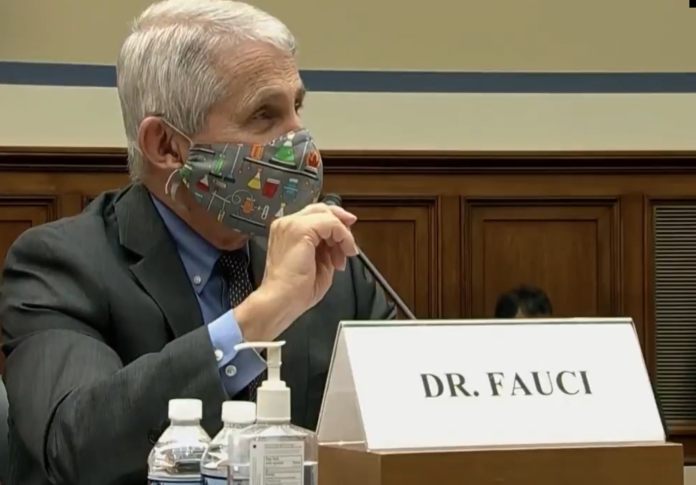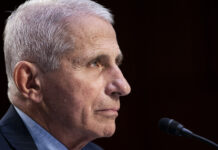
Anthony Fauci said Sunday that U.S. health officials are considering recommending that Americans get tested for the coronavirus before going back to work under the shortened isolation protocol they recently introduced.
Appearing on ABC News’s “This Week,” Fauci acknowledged the backlash over the Centers for Disease Control and Prevention reducing the recommended isolation period after a positive coronavirus test from 10 days to five. Fauci said officials may soon add a testing component at the end of the five-day period. The CDC’s shortened isolation protocol applies only to asymptomatic people.
“There has been some concern about why we don’t ask people at that five-day period to get tested. That is something that is now under consideration,” said Fauci, the chief medical adviser to President Joe Biden. “The CDC is very well aware there has been some pushback about that. Looking at it again, there may be an option in that – that testing could be a part of that. And I think we’re going to be hearing more about that in the next day or so from the CDC.”
The possibility of further changes to the CDC’s isolation guidance reflects the enormous challenge facing U.S. public health officials, who have tried balancing competing pressures in responding to the omicron wave sweeping the country. The change would mark a major reversal of one of the most criticized aspects of the new CDC guidelines – one that experts said could lead to increased viral transmission.
Federal officials faced requests from the airline and other industries to shorten quarantine and isolation times in response to worker shortages and flight cancellations that they said had been driven largely by workers who tested positive and were isolating. CDC Director Rochelle Walensky previously said that the new rules were consistent with the protections afforded by vaccinations and booster shots. The CDC also recommended that those returning to the workforce after five days continue to wear a mask for the full 10-day period.
Walensky told The Washington Post that the agency decided against requiring a negative test result after five days of isolation because the those tests are often inaccurate at that point. PCR, or polymerase chain reaction, tests can yield positive results even when the patient is not infectious, she said.
Several public health experts have challenged the revamped CDC rules, with some calling them too permissive. “I absolutely don’t want to sit next to someone who turned Positive 5 days ago and hasn’t tested [negative],” tweeted epidemiologist Michael Mina, an assistant professor at Harvard T.H. Chan School of Public Health. Mina called the guidance “reckless.”
A new testing requirement may mollify public health experts who have criticized the administration’s new guidance, but could put additional strain on the already limited testing supply. The Biden administration has faced criticism over long delays for securing tests in many parts of the country – complaints that could be amplified if tests are recommended at the end of CDC’s isolation period.
“There’s a bit of a conundrum here for the administration. Many experts have recommended testing negative to end isolation after you have covid, but it’s really hard to find tests right now,” said Larry Levitt, a public health expert at the Kaiser Family Foundation, a nonprofit. “The need for testing combined with the lack of tests has put the administration in a tough spot.”
It is also unclear whether a single rapid antigen test would provide particularly useful guidance on whether a worker is still infectious. Jorge Caballero, a former instructor at the Stanford University School of Medicine who is now working as health data scientist, said the United States should move to a system more closely resembling that in Britain, where patients are expected to test negative several times in a row before ending their isolation period. That protocol helps account for the uneven usefulness of rapid antigen tests, he said.
Including a testing requirement after five days would be an improvement, Caballero said, but “it does not address the limitations around rapid antigen tests – they are less sensitive and less able to pick up asymptomatic cases.”
Coronavirus cases have been surging across the country, but deaths have not spiked. There is some evidence that the omicron variant is less fatal than other iterations of the coronavirus. The nation is recording an average of about 400,000 cases per day, and hospitalizations have started to rise. But recent quick declines in cases in South Africa suggest that the virus may soon fade, and U.S. officials are watching what is happening both there and in Britain with guarded optimism.
The uncertain stage of the pandemic represents a new challenge for public health officials, who have already faced substantial criticism for repeated shifts in the official guidance.
“You have to balance the need for flexibility with the need for a credible consistent message, and that’s never going to be easy with a dynamic situation,” said Harold Pollack, a public health expert at the University of Chicago. “But when your recommendations change, that undermines your ability to have a stable message.”
(c) 2022, The Washington Post · Jeff Stein
{Matzav.com}












How did this little runt ever rise to power?